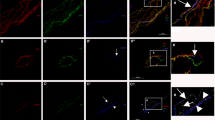Summary
This study is concerned with the distribution and ultrastructure of sensory nerve endings in the beak skin of adult Japanese quail (Coturnix coturnix japonica). The following nerve endings were found: free nerve endings, clusters of dermal Merkel nerve endings, Herbst corpuscles and Ruffmi corpuscles. The latter were found only in the dermis of the tip of the upper beak. The remaining endings were present in the skin of all areas of upper and lower beak. Free nerve endings were supplied by either thin myelinated axons or unmyelinated C-fibers and were localized in the dermis close to the basal layer of the epidermis. Merkel cells formed clusters (up to 50) localized below and between the epidermal cones of the beak skin. Disc-shaped thickenings of nerve endings were squeezed between individual Merkel cells. Small Herbst corpuscles were found in the dermis close to the epidermal cones of the beak skin. Large Herbst corpuscles occurred in deep layers of the dermis. The Ruffmi corpuscles were cylindrical in shape (80 μm × 400 μm) and arranged in groups of up to ten corpuscles. Each corpuscle was surrounded by an incomplete fibrous capsule.
Similar content being viewed by others
References
Andres KH (1969) Zur Ultrastruktur verschiedener Mechanorezeptoren von höheren Wirbeltieren. Anat Anz 124:551–565
Chambers MR, Andres KH, During von M, Iggo A (1972) The structure and function of the slowly adapting type II mechanoreceptor in hairy skin. Q J Exp Physiol 57:417–445
Gottschaldt K-M (1974) Mechanoreceptors in the beaks of birds. Symposium Mechanoreception. Rheinisch-Westfälische Akad Wiss 53:109–113
Gottschaldt K-M, Lausmann S (1974) The peripheral morphological basis of tactile sensibility in the beak of geese. Cell Tissue Res 153:477–496
Gottschaldt K-M, Fruhstorfer H, Schmidt W, Kraeft I (1982) Thermosensitivity and its possible fine-structural basis in mechanoreceptors in the beak skin of geese. J Comp Neurol 205:219–245
Halata Z (1970) Zu den Nervenendigungen (Merkeische Endigungen) in der haarlosen Nasenhaut der Katze. Z Zellforsch Mikrosk Anat 106:51–60
Halata Z (1971a) Die Ultrastruktur der Lamellenkörperchen bei Wasservögeln (Herbstsche Endigungen). Acta Anat 80:362–376
Halata Z (1971b) Ultrastructure of Grandry nerve endings in the beak skin of some aquatic birds. Folia Morphol (Praha) 19:225–232
Halata Z (1988) Ruffini corpuscle — a stretch receptor in the connective tissue of the skin and locomotion apparatus. In: Hamann W, Iggo A (eds) Progress in brain research. Transduction and cellular mechanisms in sensory receptors. Elsevier, Amsterdam, New York, pp 221–229
Halata Z (1992) Die Sinnesorgane der Haut und der Tiefensensibilität. In: Niethammer J, Schliemann H, Starck D (eds) Handbuch der Zoologie, Band VIII Mammalia, Teilband 57. De Gruyter, Berlin, pp 1–88
Halata Z, Grim M (1992) The ultrastructure of sensory nerve endings in the beak skin of the Japanese quail especially of the Ruffini corpuscle. Anat Rec 232:40 A
Halata Z, Munger BL (1980) The ultrastructure of the Ruffini and Herbst corpuscles in the articular capsule of domestic pigeon. Anat Rec 198:681–692
Halata Z, Grim M, Christ B (1990) Origin of spinal cord meninges, sheaths of peripheral nerves, and cutaneous receptors including Merkel cells. An experimental and ultrastructural study with avian chimeras. Anat Embryol 182:529–537
Kruger L, Perl ER, Sedivec MJ (1981) Fine structure of myelinated mechanical nociceptor endings in cat hairy skin. J Comp Neurol 198:137–154
Le Douarin NM (1969) Particularités du noyau interphasique chez la caill japonaise (Coturnix coturnix japonica). Utilisation de ces particularités domme “marque biologique” dans les recherches sur les interactions tissuaires et migrations cellulaires au course de l'ontogenése. Bull Biol Fr Belg 30:217–222
Malinovsky L (1967) Die Nervenendkörperchen in der Haut von Vögeln und ihre Variabilität. Z Mikrosk Anat Forsch 77:279–303
Malinovsky L, Zemanek R (1969) Sensory corpuscles in the beak skin of the domestic pigeon. Folia Morphol (Praha) 17:241–250
Quilliam TA, Armstrong J (1963) Mechanoreceptors. Endeavour 22:55–60
Saxod R (1968) Ultrastructure des corpuscles sensoriels cutanés de Herbst et de Grandry chez le canard. Arch Anat Microsc Morphol Exp 57:379–400
Saxod R (1978) Development of cutaneous sensory receptors in birds. In: Jacobson M (ed) Handbook of sensory physiology. Development of sensory systems. Springer, Berlin Heidelberg New York, pp 337–417
Author information
Authors and Affiliations
Rights and permissions
About this article
Cite this article
Halata, Z., Grim, M. Sensory nerve endings in the beak skin of Japanese quail. Anat Embryol 187, 131–138 (1993). https://doi.org/10.1007/BF00171744
Accepted:
Issue Date:
DOI: https://doi.org/10.1007/BF00171744




